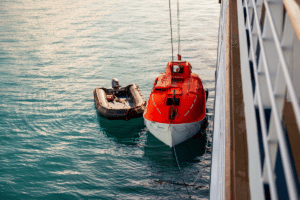According to the Maritime Accident Casebook, there are hundreds of lifeboat drill injuries in any given year. All over the world, maritime workers are injured and killed every year while practicing exercises such as abandoning ship and boat drills. Although some injuries are due to accidents that couldn’t have been avoided, most lifeboat drill injuries stem from faulty design in the lifeboat, improper training preparation, and maintenance issues. These types of injuries may fall under negligence, and therefore injured workers have the legal right to file for damages under General Maritime Law.

Lifeboat Drills Defined
Lifeboat drills, also known as a boat or abandon-ship drills, are training maneuvers carried out by a ship’s crew before setting out on a voyage on a major body of water. Lifeboat drills are intended to prepare passengers and crew to evacuate a ship in an emergency. They are usually done 30 minutes before a vessel’s scheduled departure, but per the International Convention for the Safety of Life at Sea, the drills must be done within at least 24 hours after the vessel leaves the port.
Lifeboat drills train crew members how to load and lower lifeboats. Unlike muster drills, which are carried out to inform passengers and crew about escape routes and evacuation procedures, lifeboat drills involve each step of the abandon-ship procedure. The boats are actually loaded, lowered onto the water, moved some distance from a ship, then recovered. According to international regulations, every crew member must attend one lifeboat drill and one fire drill per month.
Though lifeboat drills are intended to ensure the safety of a ship’s crew and/or passengers, they are dangerous. Many marine workers are hurt or killed every year while performing these practice runs. Per the United Press, in February of 2013, for example, five sailors were killed and three others were injured during a drill when the lifeboat they were in fell 100 feet into the water while their cruise ship was docked at a Spanish port.

Causes of Lifeboat Drill Injuries and Accidents
According to the Royal Institute of Naval Architects (RINA), lifeboat drills are becoming increasingly dangerous. The worst cases occur when crewmembers are loaded aboard lifeboats and have to rehearse the entire abandon-ship procedure. Many accidents are caused by mechanical or design flaws in the lifeboat or other equipment. Insufficient training, sloppy procedures or human error also contribute to lifeboat drill accidents.
Per the RINA, most lifeboat drill injuries fall under these categories:
- Failure of on-load release mechanism
- Unintended operation of on-load release mechanism
- Insufficient maintenance of lifeboats, davits, and launching equipment
- Communications failures
- Unfamiliarity with lifeboats, davits, equipment, and their controls
- Unsafe procedures during lifeboat drills and inspections
- Design flaws other than on on-load release mechanisms
In addition, a report commissioned by the British government states that current lifeboat design standards are outdated and fail to take into account changes in anthropometric data on a global scale. Currently, some types of lifeboats are designed to accommodate a maximum of 150 persons, with each weighing an average of 165 pounds (75 kilograms). Unfortunately, per a 2005 Centers for Disease Control (CDC) study cited by RINA, the average adult male now weighs 190 pounds (86.6 kilograms), while the average weight for adult women is 164 pounds (74.5 kilograms).
If You’ve Been Injured
If you’ve been injured due to lifeboat drill injuries, it’s important to seek immediate medical treatment. Not only is this important for your own well-being, but if your injuries are due to the negligence of another party, you’ll need to establish proof as soon as possible as you only have a certain amount of time, under maritime law, to start your case. Contact Us